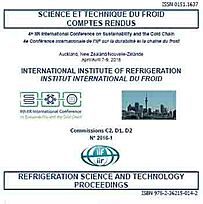
Document IIF
Étude par la mécanique numérique des fluides visant à adapter les cycles de refroidissement tout-ou-rien dans l'entreposage frigorifique des pommes pour économiser de l'énergie.
A CFD study of adapting on-off cooling cycles in apple cold stores for energy saving.
Auteurs : GRUITERS W., AMBAW A., SCHENK A., et al.
Résumé
Cooling during long-term storage of apples is a costly endeavour where electricity costs contribute up to 60% of the total variable costs at the end of storage. Here, the effect of controlling on-off cooling cycles on temperature and quality change uniformity and energy consumption is investigated with transient CFD models. The quality change of apples during the storage season as a function of position in the room is calculated with a firmness model using the FRISBEE tool. The on-off cooling cycle is regulated based on three different cooling differentials (0.4, 0.5 and 0.7°C). Temperature fluctuations were large near the edges of the stack. A
larger cooling differential led to larger fluctuations in the middle of the stack compared to the smaller differentials. Although off-cooling cycles were longer with larger differential, overall this strategy consumed more energy. Differences in apple firmness changes between the three cooling differentials are found insignificant. The smaller cooling differential resulted in a better overall performance.
Documents disponibles
Format PDF
Pages : 8
Disponible
Prix public
20 €
Prix membre*
Gratuit
* meilleur tarif applicable selon le type d'adhésion (voir le détail des avantages des adhésions individuelles et collectives)
Détails
- Titre original : A CFD study of adapting on-off cooling cycles in apple cold stores for energy saving.
- Identifiant de la fiche : 30017535
- Langues : Anglais
- Source : 4th IIR International Conference on Sustainability and the Cold Chain. Proceedings: Auckland, New Zealand, April 7-9, 2016.
- Date d'édition : 07/04/2016
- DOI : http://dx.doi.org/10.18462/iir.iccc.2016.0010
Liens
Voir d'autres communications du même compte rendu (63)
Voir le compte rendu de la conférence
Indexation
-
Thèmes :
Entrepôts frigorifiques spécialisés;
Fruits - Mots-clés : CFD; Qualité; Simulation; Pomme; Entreposage frigorifique; Économie d'energie
-
Multi-objective optimization of storage tempera...
- Auteurs : GWANPUA S. G., VERBOVEN P., VERLINDEN B. E., et al.
- Date : 02/04/2013
- Langues : Anglais
- Source : 2nd IIR International Conference on Sustainability and the Cold Chain. Proceedings: Paris, France, April 2-4, 2013.
- Formats : PDF
Voir la fiche
-
Energy conservation in fan cycled apple storage.
- Auteurs : HELLICKSON M. L., KOCA R. W., NIEMANN J., BUTTE J., BONKOWSKI D.
- Date : 1992
- Langues : Anglais
Voir la fiche
-
Redefining optimal storage conditions for apple...
- Auteurs : EAST A., TRUJILLO F., SMALE N.
- Date : 21/08/2011
- Langues : Anglais
- Source : Proceedings of the 23rd IIR International Congress of Refrigeration: Prague, Czech Republic, August 21-26, 2011. Overarching theme: Refrigeration for Sustainable Development.
- Formats : PDF
Voir la fiche
-
Modeling of the distribution and adsorption of ...
- Auteurs : TSIGE A., DELELE M. A., TIJSKENS E., et al.
- Date : 21/08/2011
- Langues : Anglais
- Source : Proceedings of the 23rd IIR International Congress of Refrigeration: Prague, Czech Republic, August 21-26, 2011. Overarching theme: Refrigeration for Sustainable Development.
- Formats : PDF
Voir la fiche
-
Controlled atmosphere storage of apples and pears.
- Auteurs : KUPFERMAN E.
- Date : 2003
- Langues : Anglais
Voir la fiche
